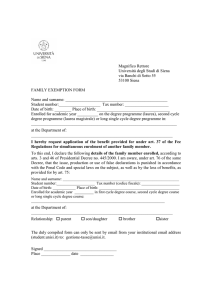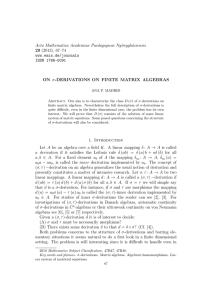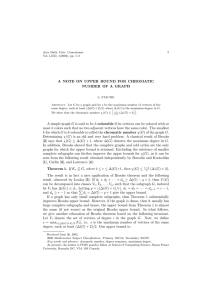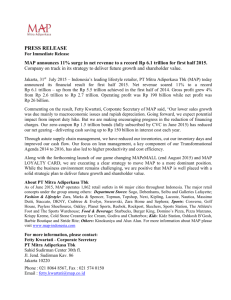Association schemes, fusion rings, C-algebras, and reality-based algebras where all nontrivial
advertisement
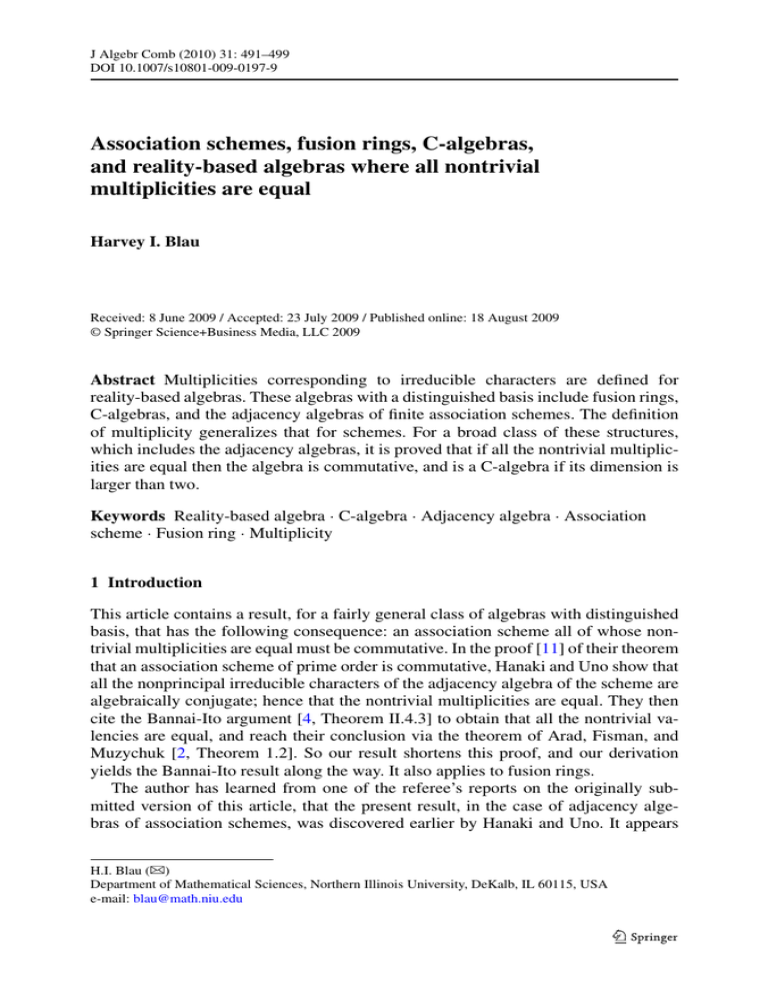
J Algebr Comb (2010) 31: 491–499
DOI 10.1007/s10801-009-0197-9
Association schemes, fusion rings, C-algebras,
and reality-based algebras where all nontrivial
multiplicities are equal
Harvey I. Blau
Received: 8 June 2009 / Accepted: 23 July 2009 / Published online: 18 August 2009
© Springer Science+Business Media, LLC 2009
Abstract Multiplicities corresponding to irreducible characters are defined for
reality-based algebras. These algebras with a distinguished basis include fusion rings,
C-algebras, and the adjacency algebras of finite association schemes. The definition
of multiplicity generalizes that for schemes. For a broad class of these structures,
which includes the adjacency algebras, it is proved that if all the nontrivial multiplicities are equal then the algebra is commutative, and is a C-algebra if its dimension is
larger than two.
Keywords Reality-based algebra · C-algebra · Adjacency algebra · Association
scheme · Fusion ring · Multiplicity
1 Introduction
This article contains a result, for a fairly general class of algebras with distinguished
basis, that has the following consequence: an association scheme all of whose nontrivial multiplicities are equal must be commutative. In the proof [11] of their theorem
that an association scheme of prime order is commutative, Hanaki and Uno show that
all the nonprincipal irreducible characters of the adjacency algebra of the scheme are
algebraically conjugate; hence that the nontrivial multiplicities are equal. They then
cite the Bannai-Ito argument [4, Theorem II.4.3] to obtain that all the nontrivial valencies are equal, and reach their conclusion via the theorem of Arad, Fisman, and
Muzychuk [2, Theorem 1.2]. So our result shortens this proof, and our derivation
yields the Bannai-Ito result along the way. It also applies to fusion rings.
The author has learned from one of the referee’s reports on the originally submitted version of this article, that the present result, in the case of adjacency algebras of association schemes, was discovered earlier by Hanaki and Uno. It appears
H.I. Blau ()
Department of Mathematical Sciences, Northern Illinois University, DeKalb, IL 60115, USA
e-mail: blau@math.niu.edu
492
J Algebr Comb (2010) 31: 491–499
on Hanaki’s website (http://math.shinshu-u.ac.jp/~hanaki) as an unpublished note remarking on [11]. It is precisely our Corollary 2 below. Our main theorem (Theorem 1 below) has more general hypotheses and a proof that is somewhat different
from theirs. In particular, we invoke neither the Frame number nor the arithmetic
mean/geometric mean inequality.
Some definitions and notation are needed to establish the context for the main
theorem.
Definition 1 [6, Definition 1.16] A reality-based algebra (RBA) (A, B) is an algebra
A over C with a distinguished basis B = {bi |0 ≤ i ≤ d}, where d < ∞, b0 = 1A , and
the following three conditions hold:
(1a) For all 0 ≤ i, j ≤ d,
bi bj =
d
βij l bl ,
l=0
where each coefficient (structure constant) βij l is in R.
(1b) There is an algebra anti-automorphism ∗ of A, such that (∗ )2 = idA and
∗
B = B. (So ∗ has order at most two, and permutes the elements of B. Set bi ∗ := bi ∗ .)
(1c) For all 0 ≤ i, j ≤ d,
βij 0 = 0
if j = i ∗ ,
and βii ∗ 0 = βi ∗ i0 > 0.
Reality-based algebras include C-algebras that are both commutative [4, 5, 13] and
noncommutative [8], table algebras that are both commutative [1] and noncommutative [2, 7, 10], and hypergroups as in [14]. The adjacency algebra, or Bose-Mesner
algebra, of an association scheme is an example of a RBA. That is, given an association scheme (in the sense of [15]) on an underlying set with n < ∞ elements,
each relation of the scheme is encoded in an n × n 0/1 matrix. The set of these adjacency matrices forms a basis for the algebra that it generates, and Definition 1 is
satisfied, where the anti-automorphism is matrix transpose. The structure constants
for an adjacency algebra are necessarily nonnegative integers. A fusion ring [9, Definition 2.1] is a RBA where all the structure constants βij l are nonnegative integers,
and all βii ∗ 0 = 1.
Definition 2 [6, Definitions 1.1d, 2.10] A degree map for a RBA (A, B) is an algebra homomorphism δ : A → C such that δ(bi ) ∈ R\{0} for 0 ≤ i ≤ d. The values
δ(bi ) are called the degrees of (A, B, δ). A degree map δ is positive if δ(bi ) > 0 for
0 ≤ i ≤ d. If δ is a degree map such that δ(bi ) = βii ∗ 0 for all i, then δ (or the triple
(A, B, δ)) is called standard.
For any degree map δ, δ(bi ) = δ(bi ∗ ) for all i (see Corollary 5 below). A given
RBA may have no degree map [6, Example 1.1] or several (e.g., (CG, G) where G is
the symmetric group Sn and δ is either the principal character or the sign character).
A RBA has at most one positive degree map (see Theorem 2 below) and indeed
has a positive degree map whenever all the structure constants are nonnegative (see
Theorem 3 below). The adjacency algebra of an association scheme has a standard
J Algebr Comb (2010) 31: 491–499
493
degree map δ, where δ(bi ) is the row sum of the 0/1 matrix bi , that is, the valency of
the corresponding relation.
Definition 3 [7, Definition 1.6], [6, Definitions 2.12, 2.13] Let (A, B) be a RBA
with given degree map δ. Then the stable degree map σ : B → R\{0} is defined by
σ (bi ) := δ(bi )2 /bii ∗ 0 , 0 ≤ i ≤ d.
The order of B (actually, of (B, δ)), is defined by
o(B) :=
d
σ (bi ).
i=0
Note that if δ is standard, then δ = σ . In particular, if (A, B) is the adjacency
algebra of an association scheme, then o(B) is the sum of the valencies; that is, the
cardinality of the underlying set of the scheme.
The basis B of a RBA can be rescaled [1, Section 2], [6, Definition 2.11], replacing
each bi by λi bi for some λi ∈ R\{0} such that λi = λi ∗ for all i and λ0 = 1. It is easily
seen that the rescaled basis again yields a RBA. The degrees and structure constants
will usually change under rescaling, but the stable degrees, and hence the order, do
not. If a degree δ(bi ) is negative, rescaling bi and bi ∗ to −bi and −bi ∗ resp. yields
positive degrees.
Definition 4 A degree map δ of a RBA (A, B) is a full degree map if δ(bi ) ≥ βii ∗ 0
for 0 ≤ i ≤ d.
If δ is standard then trivially it is a full degree map. If (A, B) is a fusion ring then
there is a unique positive degree map δ (Theorem 3 below). In this case for a fusion
ring,
d
βii ∗ l bl
δ(bi )2 = δ(bi )δ(bi ∗ ) = δ(bi bi ∗ ) = δ 1 · b0 +
l=1
=1+
d
βii ∗ l δ(bl ) ≥ 1.
l=1
So δ(bi ) ≥ 1 = βii ∗ 0 , and δ is a full degree map. Furthermore, if δ(bi ) = 1 for all i
then B is a group.
Every reality-based algebra (A, B) is semisimple [6, Proposition 2.3], [12, Section 5]. So the irreducible characters χs of A are in bijection with the primitive central
idempotents es of A, 1 ≤ s ≤ k: A = ⊕ks=1 es A; es A ∼
= Mns (C), a full matrix alge(ns ∈ Z>0 ); χs (et A) = 0 if s = t, and χs (es ) = χs (1) = ns . Thus,
bra of degree ns d + 1 = dim A = ks=1 ns 2 , and A is commutative if and only if ns = 1 for 1 ≤ s ≤ k.
Since any degree map is an irreducible character, when there is a degree map δ that
we distinguish, we denote it as δ = χ1 .
494
J Algebr Comb (2010) 31: 491–499
Definition 5 Let (A, B) be a RBA. A feasible trace function [2, 12] is a linear map
φ : A → C such that φ(xy) = φ(yx) for all x, y ∈ A.
Since A is semisimple and since the only feasible trace functions on a full matrix
algebra are scalar multiples of the ordinary trace, it follows that any feasible trace
function on A is a linear combination of the irreducible characters χs .
Definition 6 [3, Section 3] Let (A, B) be a RBA with degree map δ = χ1 and order o(B) (with resp. to δ). The standard feasible trace function is the linear map
τ : A → C such that τ (b0 ) = o(B) and τ (bi ) = 0, all 1 ≤ i ≤ d.
It follows from Definition 1c that τ is indeed a feasible trace map.
Definition 7 Let (A, B) be a RBA with degree map δ = χ1 and consequent standard
feasible trace τ . The multiplicities ms , 1 ≤ s ≤ k, for (A, B, δ = χ1 ) are defined as
the coefficients in the equation
τ=
k
ms χs .
s=1
The multiplicities are positive real numbers, and m1 = 1 (see Proposition 1 and
Corollary 6 below). As is well known, the feasible trace function for the adjacency
algebra of an association scheme is the character of the standard module, and the
ms are positive integers. Note that the irreducible characters, standard feasible trace
function, and multiplicities of a RBA are not affected by rescaling the distinguished
basis.
Now we can state the main theorem.
Theorem 1 Suppose that (A, B) is a RBA with a full degree map δ = χ1 . Suppose
as well that all the structure constants βij l are integers. If the multiplicities ms are
equal for all 2 ≤ s ≤ k, then A is commutative and the degrees χ1 (bi ) are equal
for all 1 ≤ i ≤ d. Furthermore, if d ≥ 2 then χ1 (bi ) = βii ∗ 0 for 0 ≤ i ≤ d; that is,
(A, B, χ1 ) is standard.
Remark 1 (i) When d = 1 under the hypotheses of the theorem, then χ1 (b1 ) and
o(B) need not be integers. This case is discussed after the proof of the theorem in
Section 3.
(ii) When d ≥ 2 under the hypotheses of the theorem, then (A, B) is a commutative C-algebra; that is, a commutative RBA with a standard degree map χ1 . Then
B gives rise to a dual basis B̂, where {ms }ks=1 is the set of standard degrees for B̂
(k = d + 1) and o(B) = o(B̂) (see [4, Section II.5] or [5, Section 2]). So from Theorem 1, 1 + dχ1 (b1 ) = o(B) = 1 + dm2 . Hence, the constant multiplicities equal the
constant degrees.
Corollary 1 Suppose that (A, B) is a fusion ring with δ = χ1 , the unique positive
degree map. If the multiplicities ms are equal for 2 ≤ s ≤ k then A is commutative and
J Algebr Comb (2010) 31: 491–499
495
the degrees χ1 (bi ) are equal for 1 ≤ i ≤ d. Also, if d ≥ 2 then all degrees χ1 (bi ) = 1
and B is an abelian group.
Corollary 2 Suppose that (A, B) is the adjacency algebra of an association scheme,
with δ = χ1 the standard degree map. If the multiplicities ms are equal for all 2 ≤
s ≤ k then A is commutative and the valencies χ1 (bi ) are equal for all 1 ≤ i ≤ d.
Some known results on RBAs are collected in Section 2. The proof of Theorem 1
is given in Section 3.
2 Known results
Some of the proofs that are not included in this section are found explicitly in [2]. Others are implicit in the proofs of special cases in [12], [4], [1], or [5]; and still others are
straightforward from first principles. We retain the notation from Section 1. Throughout, (A, B) is a RBA with a distinguished degree map δ, anti-automorphism ∗ ,
and basis B = {b0 = 1A , b1 , . . . , bd }; the irreducible characters of A are denoted as
δ = χ1 , χ2 , . . . , χk with χs (1) = ns ∈ Z>0 for 1 ≤ s
≤ k; the corresponding primitive
central idempotents are es for 1 ≤ s ≤ k; and τ = ks=1 ms χs is the standard feasible trace map, so that the ms are the multiplicities. The structure constants for B are
again denoted as βij l , 0 ≤ i, j, l ≤ d.
Proposition 1 For all 1 ≤ s ≤ k, ms > 0.
Proof For all x ∈ A, with x =
d
i=0 αi bi
x :=
for αi ∈ C, define
d
αi bi ,
i=0
where αi denotes the complex conjugate of αi . Then for all x, y ∈ A, (x + y) = x +y;
and since all the βij l are real, (xy) = x y. Hence,
{es |1 ≤ s ≤ k} = {es |1 ≤ s ≤ k} = {es ∗ |1 ≤ s ≤ k}.
Also, τ (xx ∗ ) = o(B) di=0 αi αi βii ∗ 0 > 0 for all x ∈ A with x = 0. So τ (es es ∗ ) > 0.
∗
∗
∗
Since
k either es = es or es es = 0, it follows that es = es and τ (es ) > 0. But τ (es ) =
u=1 mu χu (es ) = ms ns . Hence, ms > 0.
Definition 8 If φ ∈ HomC (A, C) and σ is a field automorphism of C, the functional
φ σ ∈ HomC (A, C) is defined as the C-linear map: A → C such that φ σ (bi ) = φ(bi )σ ,
for all bi ∈ B.
Proposition 2 Suppose that X : A → Mn (C) is a representation of A that affords
the character χ . Let X(bi ) = (xj l (bi )), the n × n matrix with j, l entry xj l (bi ) ∈ C.
Define X σ (bi ) = ((xj l (bi ))σ ), and extend X σ C-linearly to A. If βijσ l = βij l for all
0 ≤ i, j, l ≤ d, then X σ is also a representation of A, and it affords the character χ σ .
Furthermore, χ is irreducible if and only if χ σ is irreducible.
496
J Algebr Comb (2010) 31: 491–499
Corollary 3 Suppose that βij l ∈ Q, 0 ≤ i, j, l ≤ d. Let σ be a field automorphism
of C. Then the correspondence χs → χsσ , 1 ≤ s ≤ k, is a permutation of the irreducible characters of A.
Definition 9 Define ζ as the sum of the irreducible characters of A; that is,
ζ :=
k
χs .
s=1
Proposition 3 Suppose that βij l ∈ Z, 0 ≤ i, j, l ≤ d. Then χs (bi ) is an algebraic
integer for 0 ≤ i ≤ d and 1 ≤ s ≤ k; and ζ (bi ) ∈ Z.
Proof The eigenvalues of each matrix (βij l ) (rows/columns indexed by j /l, for
0 ≤ i ≤ d) are algebraic integers. Since A is semisimple, the (left) regular representation of A with respect to B is equivalent to a representation where each irreducible
representation of A (up to equivalence) appears as a diagonal block, and the entries
below these blocks are zero. It follows that each χs (bi ) is an algebraic integer. That
ζ (bi ) ∈ Z follows from Corollary 3.
Definition 10 The symmetric bilinear form , on HomC (A, C) is defined as follows: for all φ, θ ∈ HomC (A, C),
d
1
φ, θ =
φ(bi )θ (bi ∗ ).
βii ∗ 0
i=0
Theorem 2 (Orthogonality Relations [12, (5.4)], [5, Proposition 2.11], [4, Theorem II.5.5]) For all 1 ≤ s, t ≤ k,
χs , χt = δst o(B)
ns
.
ms
Corollary 4 For all 1 ≤ s ≤ k, χs is an irreducible character of A, and χs (bi ) =
χs (bi ∗ ) for all 0 ≤ i ≤ d.
Proof The first statement follows from Proposition 2, since all βij l ∈ R. If X is an
irreducible representation of A that affords χs , then
bi −→ transpose(X(bi ∗ ))
defines another irreducible representation, whose trace at bi is χs (bi ∗ ). So there exists
an irreducible character χ̃ with χ̃ (bi ) = χ(bi ∗ ) for all 0 ≤ i ≤ d. By Definition 10,
and since χs (1) = ns > 0,
χs , χ̃ =
d
d
1
1
χs (bi )χ̃ (bi ∗ ) =
χs (bi )χs (bi ) > 0.
βii ∗ 0
βii ∗ 0
i=0
i=0
By Theorem 2, χ(bi ∗ ) = χ(bi ) for all i. The second claim follows.
J Algebr Comb (2010) 31: 491–499
497
Corollary 5 (i) If δ is any degree map then δ(bi ) = δ(bi ∗ ) for all bi ∈ B. (ii) A has
at most one positive degree map.
Corollary 6 If δ = χ1 is any distinguished degree map, and if o(B) is defined in
terms of δ, then m1 = 1.
n1
= o(B)/m1 . But by Definition 10, CorolProof By Theorem 2, χ1 , χ1 = o(B) m
1
lary 5(i) and Definition 3,
χ1 , χ1 =
d
χ1 (bi )2 /βii ∗ 0 = o(B).
i=0
Theorem 3 ([1, Lemma 2.9], [2, Theorem 3.14]) If all βij l ≥ 0 then A has a positive
degree map.
3 Proof of Theorem 1
Let (A, B) be a RBA with a full degree map χ1 that satisfies the hypotheses of Theorem 1. The notation from the previous sections is in force. We assume that d > 0
and hence k > 1, as otherwise everything is trivial. Let t denote the constant value
ms for 2 ≤ s ≤ k. Then t > 0 by Proposition 1. Now by Definition 7, Corollary 6, and
Definition 9,
τ = χ1 + t
χs = tζ + (1 − t)χ1 .
(1)
s≥2
Since τ (bi ) = 0 for all bi = b0 , we have
1
χ1 (bi ), all 1 ≤ i ≤ d.
ζ (bi ) = 1 −
t
(2)
So by Proposition 3,
1−
1
χ1 (bi ) ∈ Z, all 1 ≤ i ≤ d.
t
(3)
Also from (1), we have
o(B) = τ (1) = χ1 (1) + t
s≥2
χs (1) = 1 + t
(4)
ns .
s≥2
By hypothesis, χ1 (bi ) ≥ βii ∗ 0 ∈ Z>0 for 0 ≤ i ≤ d. This and (4) yield
d +1≤
d
βii ∗ 0 ≤
i=0
≤1+t
s≥2
d
χ1 (bi ) ≤
i=0
ns 2 = 1 + dt.
d
i=0
χ1 (bi )2 /βii ∗ 0 = o(B) = 1 + t
ns
s≥2
(5)
498
J Algebr Comb (2010) 31: 491–499
If t = 1, then all the inequalities of (5) must be equalities. In particular, ns 2 = ns
for all s ≥ 2, so that ns = 1 for 1 ≤ s ≤ k and A is commutative. Also, χ1 (bi ) =
βii ∗ 0 = 1 for all i, so that (A, B, χ1 ) is standard and the conclusion of Theorem 1
holds. Thus we may assume henceforth that t = 1.
For any field automorphism σ of C, each χs σ is an irreducible character of A, by
Proposition 2, and
χsσ .
(6)
τ σ = χ1σ + t σ
s≥2
Since
τ σ (b
i ) = τ (bi
)σ
= 0 for bi = b0 , and
τσ =
τ σ (b
σ
0 ) = o(B) ,
we have
o(B)σ
o(B)σ
o(B)σ τ=
χ1 +
t
χs .
o(B)
o(B)
o(B)
(7)
s≥2
So if k > 2, then (6), (7), t = 1, and linear independence of the χs imply that
σ
σ
σ
χ1σ = o(B)
o(B) χ1 , hence χ1 = χ1 and o(B) = o(B) for all automorphisms σ of C.
Thus if k > 2, then χ1 (bi ) ∈ Q for 0 ≤ i ≤ d. Since χ1 (bi ) is an algebraic integer
(Proposition 3), it follows that χ1 (bi ) ∈ Z for 0 ≤ i ≤ d, and o(B) ∈ Q. Similarly, if
k = 2 but χ1σ = χ1 for all automorphisms σ of C, then χ1 (bi ) ∈ Z for all i. If k = 2
and χ1σ = χ2 = χ1 for some σ then n2 = n1 = 1 implies that A is commutative, and
d + 1 = k = 2.
So it suffices to assume for the rest of the proof that t = 1 and χ1 (bi ) ∈ Z for
0 ≤ i ≤ d. Then by (3),
1
χ1 (bi ) ∈ Z>0 , all 1 ≤ i ≤ d.
t
By (4), t = (o(B) − 1)/ s≥2 ns . Then (8) yields
ns · χ1 (bi )/(o(B) − 1) ∈ Z>0 ,
(8)
all 1 ≤ i ≤ d,
s≥2
so that
o(B) − 1 ≤
ns · χ1 (bi ),
all 1 ≤ i ≤ d.
(9)
s≥2
Let β = mini>0 χ1 (bi ). Then (9), in combination with part of (5), gives us
dβ ≤
d
χ1 (bi ) ≤
i=1
≤
ns
2
d
2
χ1 (bi ) /β
i=1
· β = dβ.
ii ∗ 0
= o(B) − 1 ≤
ns · β
s≥2
(10)
s≥2
So all the inequalities of (10) are equalities. Then s≥2 ns = s≥2 ns 2 implies that
all ns = 1 and A is commutative. Also, dβ = di=1 χ1 (bi ) = di=1 χ1 (bi )2 /βii ∗ 0 ,
J Algebr Comb (2010) 31: 491–499
499
with β ≤ χ1 (bi ) ≤ χ1 (bi )2 /βii ∗ 0 , yields that β = χ1 (bi ) = βii ∗ 0 , all 1 ≤ i ≤ d. The
proof is complete.
Remark 2 Suppose that (A, B) is a RBA with integer structure constants and d = 1.
Then B = {b0 , b1 } and b1 2 = β110 b0 + β111 b1 . So A has two irreducible characters χ1 and χ2 , with χ1 (b0 ) = χ2 (b0 ) = 1. Furthermore, χ1 (b1 )and χ2 (b1 ) are the
roots of the polynomial x 2 − β111 x − β110 = 0, namely (β111 ± β111 2 + 4β110 )/2.
This RBA exists for any choice of β110 ∈ Z>0 and β111 ∈ Z. Let χ1 (b1 ) = (β111 +
β111 2 + 4β110 )/2. Then χ1 is a full degree map if and only if β111 ≥ β110 − 1.
But χ1 (b1 ) is not necessarily an integer, much less necessarily equal to β110 . Finally,
(A, B) is a fusion ring if and only if β110 = 1 and β111 ∈ Z>0 .
References
1. Arad, Z., Blau, H.I.: On table algebras and applications to finite group theory. J. Algebra 138, 137–185
(1991)
2. Arad, Z., Fisman, E., Muzychuk, M.: Generalized table algebras. Israel J. Math. 114, 29–60 (1999)
3. Bagherian, J., Barghi, A.R.: Standard character condition for C-algebras, arXiv:0803.2423 [Math. RT]
(17 March 2008)
4. Bannai, E., Ito, T.: Algebraic Combinatorics I. Association Schemes. Benjamin/Cummings, Menlo
Park (1984)
5. Blau, H.I.: Quotient structures in C-algebras. J. Algebra 175, 24–64 (1995)
6. Blau, H.I.: Table algebras. European J. Combin. 30, 1426–1455 (2009)
7. Blau, H.I., Zieschang, P.-H.: Sylow theory for table algebras, fusion rule algebras, and hypergroups.
J. Algebra 273, 551–570 (2004)
8. Evdokimov, S.A., Ponomorenko, I.N., Vershik, A.M.: Algebras in Plancherel duality and algebraic
combinatorics. Funct. Anal. Appl. 31, 252–261 (1997)
9. Gelaki, S., Nikshych, D.: Nilpotent fusion categories. Adv. Math. 217, 1053–1071 (2008)
10. Green, R.M.: Tabular algebras and their asymptotic versions. J. Algebra 252, 27–64 (2002)
11. Hanaki, A., Uno, K.: Algebraic structure of association schemes of prime order. J. Algebraic Combin.
23, 189–195 (2006)
12. Higman, D.G.: Coherent algebras. Linear Algebra Appl. 93, 209–239 (1987)
13. Kawada, Y.: Über den Dualitätssatz der Charaktere nicht commutativen Gruppen. Proc. Phys. Math.
Soc. Japan 24(3), 97–109 (1942)
14. Sunder, V.S., Wildberger, N.J.: Actions of finite hypergroups. J. Algebraic Combin. 18, 135–151
(2003)
15. Zieschang, P.-H.: An Algebraic Approach to Association Schemes. Lecture Notes in Mathematics,
vol. 1628. Springer, Berlin (1996)
